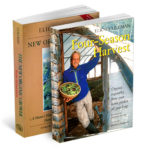Downloads
 Bed Preparation Worksheet
Bed Preparation WorksheetDownload the worksheet for this session. Space has been provided for those who would like to take notes. 🙂
Extra Resources
GrowVeg has a very good article on Treating Wood for Vegetable Gardens. This article lists several natural solutions to preserving your wood.
A couple natural wood treatment products include:
LifeTime® Wood Treatment
Eco Wood Treatment
A good soil mix recipe for a raised bed
Equal mixture of the following:
- Equal mixture of quality compost or worm castings with topsoil
- Coarse sand (fine will do as well)
- Peat moss
- Vermiculite or perlite (optional for moisture retention)
Soil Booster Mix
 100% Organic Container Booster Mix from the Vermont Compost Company.
100% Organic Container Booster Mix from the Vermont Compost Company.
This is a 100% natural and organic way to revitalize soil in containers providing nutrients and trace elements to keep plants lush and healthy.
Suggested Reading

For a deeper look into this module read the following:
Four Season Harvest: p. 31-40; 46-54
The New Organic Grower: p. 33-49
9 Comments
Lori Gulley
April 15, 2014What is the difference between adding amendments before using the broadfork and raking over with the bed preparation rake vs. the method presented in this lesson?
Paul
April 15, 2014Great question! The main difference is simply the order in which it is done. I don’t see any problem with putting your amendments on before broadforking the bed. You’ll still want to stir the amendments in softly with the three prong cultivator after broadforking though.
Melody
March 19, 2015I see your recipe for the soil for a raised bed above. My question is: Where do you get that much compost or worm castings from? That’s an awful lot of compost if one is doing several raised beds.
Paul
March 19, 2015Hi Melody, great question. It may be a little confusing how it’s written there – but I think you’ll find that it isn’t as much compost as you may be thinking. Let’s say you have a 4′ x 8′ raised bed that’s 8 inches high. You would need a total of 22 cubic feet of soil to fill it. In the recipe above 1/8th of that will be compost (you’ll mix it half and half with top soil so that 1/4 of the mix is a top soil/compost blend). This means you’ll need 2.75 cubic feet of compost/worm castings for one bed. You can usually buy compost in 1-2 cubic foot bags.
Now sourcing the compost may prove a little challenge. Of course you can purchase compost from garden centers like at Lowes… but I’d suggest looking for better sources then that. You may want to check in with local nurseries or organic farms and ask them where you can purchase good quality organic compost or worm castings. They may even be purchasing compost in bulk and be willing to sell you some that way. It’s worth doing a little research and looking around.
Does that make sense? Let me know if you still have some questions!
Yvonne
April 16, 2015Paul, is it a good idea to add compost that hasn’t broken down completely to a new garden plot before using a rototiller and after removing the grass that was there before, or should I avoid using that compost and look for other ammendments instead? (We just moved and only started this new compost in December.) Also, I believe that the soil may be acidic due to the growth of many pine trees and also a bit sandy. Any guidance in this matter would be appreciated. Thank you:)
Paul
April 17, 2015Hi Yvonne – thanks for your question! About the compost first: depending on how broken down your compost is, it may not hurt to add it. If it is still pretty fresh (not really broken down much at all) I’d encourage you to wait. Adding too much fresh organic matter can tie up the nitrogen in the soil making it hard on your plants to grow. If you did decide to add fresh organic matter you will probably want to wait a few weeks before planting.
And regarding your soil’s acidity – you’ll probably want to check the pH before doing anything to it (you should be able to find simple pH testing kits at your local garden center – or there are many available online). Of course, adding lots of quality compost will help balance it no matter where it is – but if it is acidic you may need to resort to other methods to balance it faster. Here is a good article about improving acidic soil. Let me know how it comes!
Bill
May 30, 2018You show a bag of Soil Booster Mix above. Is that to be part of the original mixture or to be added to a bed at a later time?
Paul
May 31, 2018Hi Bill, great question! I actually should update the page here. I would now recommend using Down to Earth Vegan Mix.
And yes, I would use the mix in the original soil mixture and then you will need to add some over time as you grow your plants. The Vegan Mix comes with instructions on how much and how often to revitalize your soil with the mix.
Micah
November 11, 2019Hey Paul,
I’ve been looking on Johnny’s Seeds web site at the broadforks, and I’m not sure whether to get the hard pan broadfork or the regular one. We have tilled our soil at the beginning of each year with a rototiller and I cultivate with a stirrup hoe regularly. We have clay soil and, although I’ve been able to get the top 2-3 inches to that cake consistency you talked about in the video, I think that’s as deep as it goes.
Which fork do you recommend I get?
Thank you.